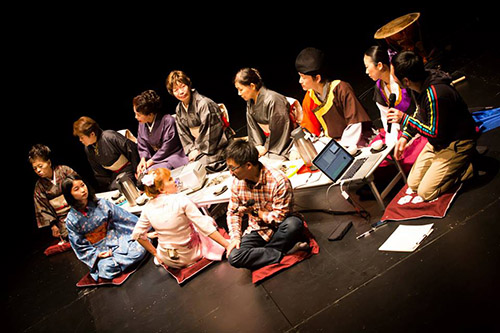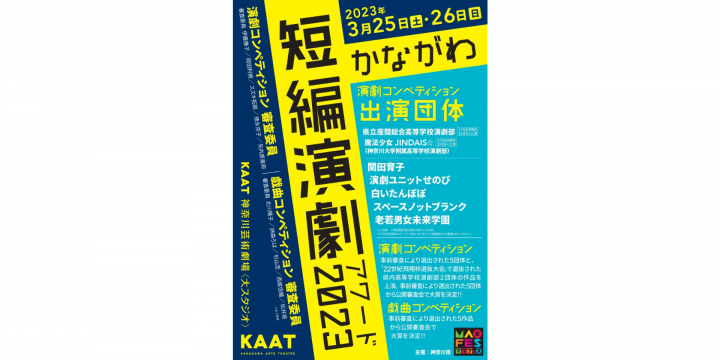Magcal Report in TPAM 2014 / TPAM Direction, Yokobori Fumi Direction

What is TPAM Direction?
Young creators engaged in unique activities have been appointed as directors, and the program will be created with original concepts and new perspectives.
This will be an opportunity to share contemporary ideas and challenges through each other's direction and to consider together the possibilities of performing arts.
/////////////////////////////////////////////////// /////////////////////////////////////////////////// /////////////////////////////////////////////////// //////
Direction by Fumi Yokobori
・Jun Tsutsui + People Dancing in Shin-Nagata "The Dance Scene in Shin-Nagata"
・Sioned Hughes, "Aomori, Aomori"
KAAT Kanagawa Arts Theatre <Large Studio>
2.13 Thu 16:30/2.14 Fri 16:30
Fumi Yokobori has directed two works: Jun Tsutsui + People Dancing in Shin-Nagata: "The Dance Situation in Shin-Nagata" and
The event featured two consecutive performances of Sioned Hughes's "Aomori, Aomori."
■Jun Tsutsui + People Dancing in Shin-Nagata "The Dance Scene in Shin-Nagata"
"The Dance Scene of Shin-Nagata" is a continuing project that began in 2009 with the concept of "meeting people who dance in Shin-Nagata", researching dance and traditional dance through the various dancers active in Shin-Nagata and getting to know the area. The project featured director Tsutsui Jun introducing dancers who are actually active in Shin-Nagata while showcasing the dance scene in Shin-Nagata.
When I first entered the venue, there was a long table and a set of snacks like those you would find in a community center next to the large screen, and just when I thought the dancing was about to begin when the performance time came, an older woman...or rather, a group of women a little older than me came out from the back and began chatting and eating snacks.
Well, it's difficult to explain, so to be honest, it was a tea party hosted by middle-aged ladies, the kind of thing I've seen somewhere before.
If you pass by, you'll definitely be approached and offered a candy.
"What on earth is about to happen?" I wondered, and my interest was drawn more and more by the unexpected developments that unfolded in the space of the theater.
Also appearing in the program at KAAT were Jun Tsutsui, who is a stranger in Shin-Nagata, and interpreter Taku Ito; the members of the Fujita Sachiko Dance Studio, who appeared above; Kitano Masa Win, who runs a Burmese restaurant and also dances Burmese traditional dance; contemporary dancer Juri Nishioka; and Korean traditional dancers Emi Cho and Won Park.
By the way, the reason we prepared a tea party set that looks like it came from a community center is that Tsutsui-san had a real-life experience during his research when he went to interview the Fujita Sachiko Dance Studio, which is cooperating with this project, and was always treated to so many snacks that he would end up full before the actual practice even began.

First, let me explain the details of the performance. It was a simple program that consisted of interviews with each dancer, followed by a talk and then a performance of their dance in front of the audience.
When you hear that, it may seem like we're just introducing local topics, but I don't think so.
As I wrote at the beginning of this article, "An unexpected development in the space of a theater," it may be important that I already had a certain image in my mind of "something that can be expressed in a theater."
To quote from the text distributed at the venue, this direction:
"An Inevitability in Daily Life"
"Something that loosely connects people, roots and communities"
The perspective that it is an expression that goes back and forth between "dance as an act shown in a theater, etc."
I would like to draw your attention to the following.
In that respect, I felt that Shin-Nagata's presentation clearly drew attention to aspects of the activity of "dance" that we knew about but had not been aware of until then, by presenting the necessity of the activity of "dance" in everyday life, the roots of the region, and relationships as a community in the space of a "theater" while maintaining the atmosphere of the time of the interview.
In particular, I have often seen the "Shin Buyo" dance that was performed to Enka (popular songs) on TV, at rural hot spring centers, and other places, but I had never paid much attention to the origins of the dance, and, with all due respect, may not have even thought of it as a "dance"...
Looking back, I find it strange that I had not noticed this before, but even just in the "dance" section of this event, I think there are many things that have been passed down as a matter of necessity in everyday life, some of which have been put into words, such as "traditions," and others that have been passed down more intuitively.
"To Dance"
I think this project made me think about the most important aspects of dance, both its fun and difficulty, and at the same time, I felt that this program had made me even more interested and attracted to dance.
■ Sioned Hughes "Aomori, Aomori"
Continuing from above, the venue was rearranged and Sioned Hughes's "Aomori, Aomori" was then performed.
Sioned Hughes is based in London, and the piece she performed this time was created with local dancers and musicians while she was staying in Aomori.
Like "The Dance Situation in Shin-Nagata," this work focuses on regional characteristics, but I believe it is also a work that is truly "in collaboration with the regional characteristics."
There was no stage equipment, just a large space. At the back stood a Tsugaru shamisen player and a singer, and the dance unfolded to the powerful sound of the Tsugaru shamisen.
To honestly describe the characteristics of the dance, the analogy of "dancing while lying down" or "swimming on the ground" might be appropriate.
However, in contrast to the dancer dancing while lying down, only one dancer was standing, and the two directions of gravity reminded me of the image of watching a single dance from various angles and on various time axes, which seemed to be the trajectory of the dance that had been created in Aomori.
The occasional sight of children and adults passing by brings to mind encounters with people in Aomori, and the white balls being thrown in seem to represent the snowy scenery of Aomori.
The powerful Tsugaru shamisen performance and the delicate, beautiful, perfect breathing of the dance create the feeling of swimming on the floor. Not only is the dance beautiful, it is a dance that can be enjoyed from many different angles, as it intertwines Sioned Hughes's feelings about tradition and her memories of Aomori.

In this way, the keyword "regionality" is a common theme for both "Shin-Nagata Dance Circumstances" and "Aomori, Aomori."
The combination of these two different approaches is
"An Inevitability in Daily Life"
"Something that loosely connects people, roots and communities"
The perspective that it is an expression that goes back and forth between "dance as an act shown in a theater, etc."
I think it was a wonderful combination, gently guiding people in both directions while also making powerful suggestions.



